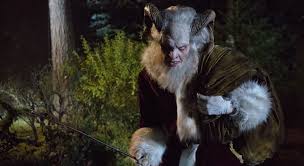Who Is Krampus?

December 8, 2015
Editor’s Note: With the release of the new Krampus movie, the Johnny Green’s Richard Justian took a little time to track down the background of this little-known holiday character.
St. Nicholas traditions vary from place to place. This is most evident when looking at the characters who accompany him on his gift giving journeys. Many of these customs are rooted in the Middle Ages, which had a strong fascination with the tension between good and evil. St. Nicholas, as a benevolent Patron, represents the good. But he sometimes comes with others who symbolize evil. One such companion is the Krampus, found with St. Nicholas in Austria, Southern Germany, and several other Eastern European areas.
This beast with Germanic roots is St. Nicholas’s other half. Half goat, half demon but can also be depicted as a sinister gentleman with a dapper demeanor dressed in black. He scares children into being nice, not naughty. Bearing horns, dark hair, and engorged red tongue, the helper of St. Nicholas comes bound in chains (to show he is under the saint’s control and would not be able to harm those who are undeserving of Krampus’s mischief ). Along with a bundle of birch sticks meant to swat naughty children. He then hauls the naughty kids down to the underworld.
Krampus, whose name is derived from the German word krampen, meaning claw, is said to be the son of Hel in Norse mythology. According to folklore, Krampus purportedly shows up in towns the night before December 6, known as Krampusnacht, or Krampus Night.
December 6 also happens to be Nikolaustag, or St. Nicholas Day, when German children look outside their door to see if the shoe or boot they’d left out the night before contains either presents (a reward for good behavior) or a rod (bad behavior). The tradition in Austria, Germany, Hungary, Slovenia, and the Czech Republic involves Scores of drunken men dressed as devils, who take over the streets for a Krampuslauf—a Krampus Run of sorts, when people are chased through the streets by the “devils.” Krampus’ frightening presence was suppressed for many years—the Catholic Church forbade the raucous celebrations, and fascists in World War II Europe found Krampus despicable.
But Krampus is making a comeback now, thanks partly to a “bah humbug” attitude in pop culture caused by the commercialization of Jolly Ol’ Saint Nick. In the U.S., people are buying into the trend with Krampus parties. Austria is attempting to commercialize the harsh persona of Krampus by selling chocolates, figurines, and collectible horns.
Krampus throughout the ages
2000 BC Enkidu appears in the Epic of Gilgamesh, the earliest known appearance of a ‘Wild Man’ in literature.
600 BC In the book of Daniel in the Old Testament, King Nebuchadnezzar is punished by God for his pride when he is turned into a hairy beast.
217 BC Saturnalia is introduced as a winter celebration in Rome, marked by gift giving, wild parties, and a reversal of the normal social roles of slave and master.
4th Century AD due to Roman influence, many Germanic tribes, such as the Goths and Vandals, convert to Christianity; their pagan traditions survive in small villages in the Alps where the Church cannot penetrate.
1250 AD King’s Mirror, a Norwegian text, features a Wild Man character who is described as being covered in hair.
17th Century AD ‘Knecht Rupert’ appears as a figure in a Nuremberg Christmas procession.
1810 AD The Brothers Grimm began publishing stories of Germanic folk tales, marking a resurgence in Germanic pagan folklore.
Early 19th Century AD Holiday postcards from Austria, Germany, and other parts of Europe feature holiday greetings Krampus and other companions of St. Nicholas.
Early 19th Century AD Germanic and Dutch immigrants to the US popularize ‘Pelznickel’ traditions in Pennsylvania, Maryland, and as far west as Indiana.
2004 AD Blab! Magazine curator Monte Beauchamp publishes Devil In Design, a collection of vintage Krampus postcards from the turn of the 19th century. This book marks an increase in Krampus’ popularity in the English speaking world.
2004 AD An Adult Swim show The Venture Brothers features Krampus during a Christmas special.
2007 AD The American television show Supernatural features an evil Krampus character.
2009 AD American satirist Stephen Colbert is visited by Krampus on his television show The Colbert Report.
2013 AD Krampus comes to the popular American television show Grimm.
2013 AD Krampus featured on the popular animated television show American Dad.